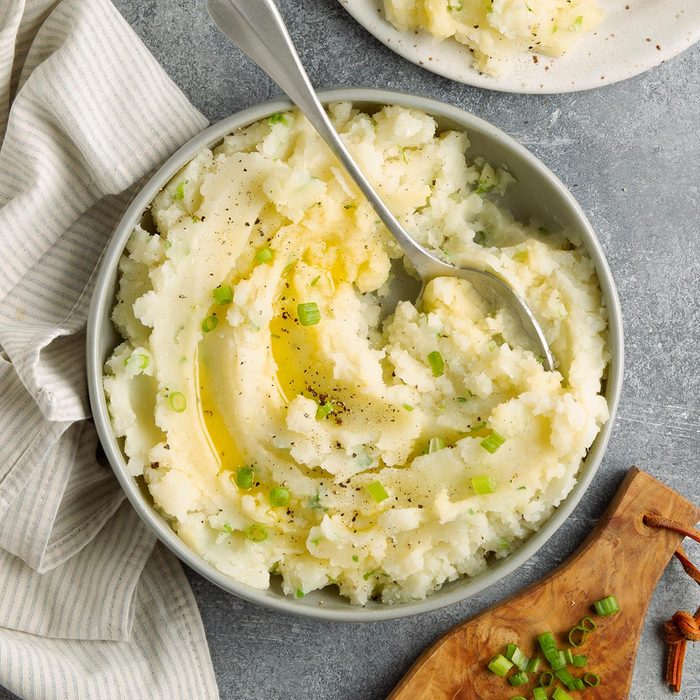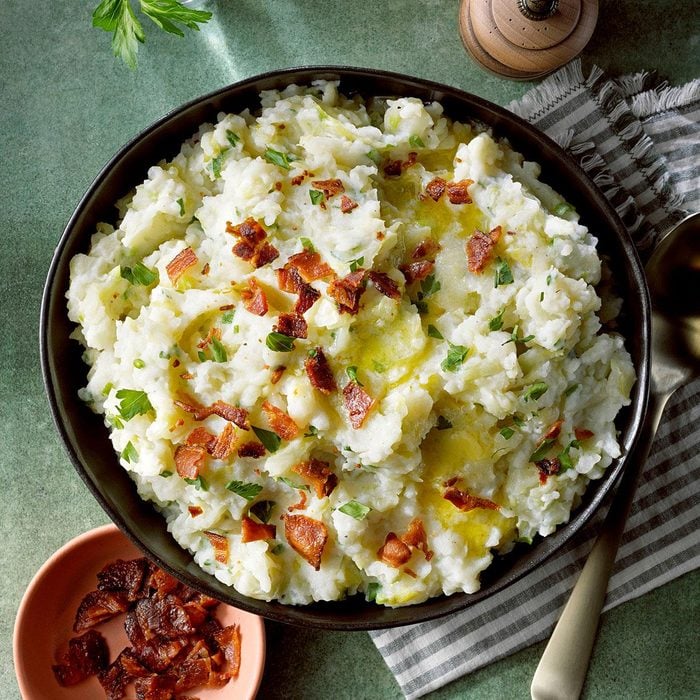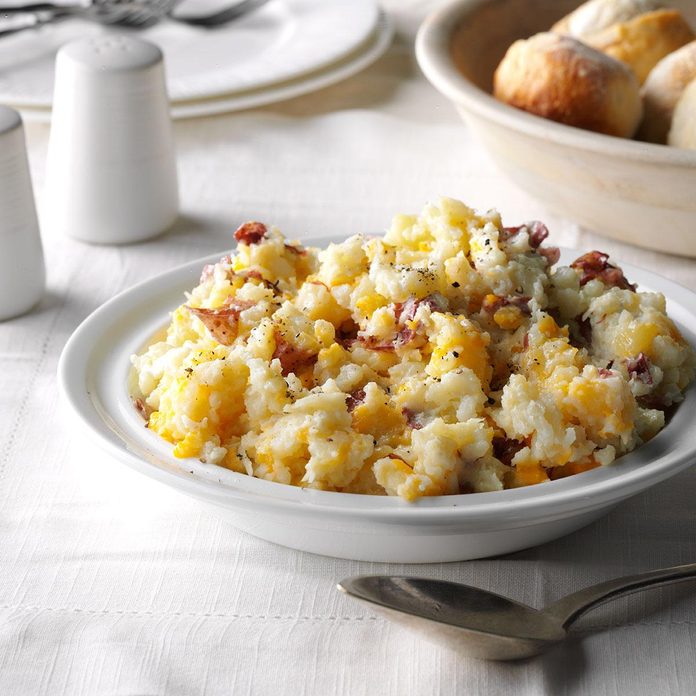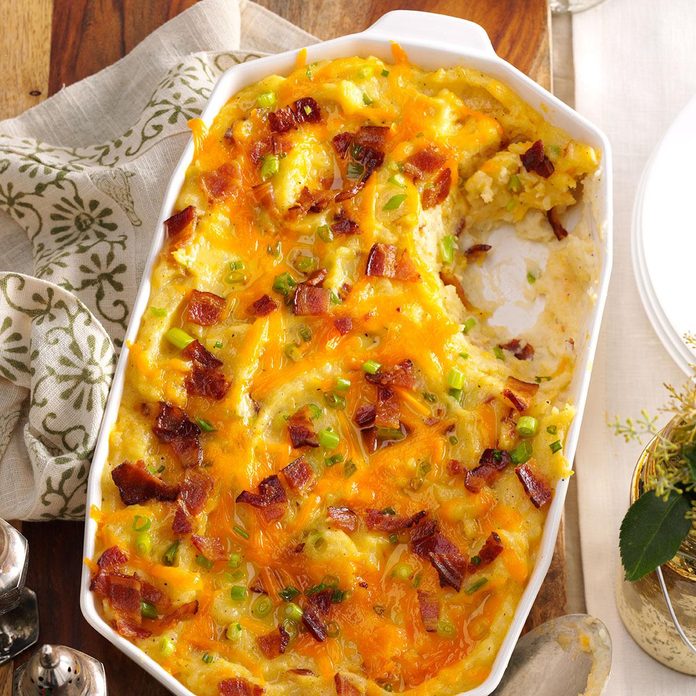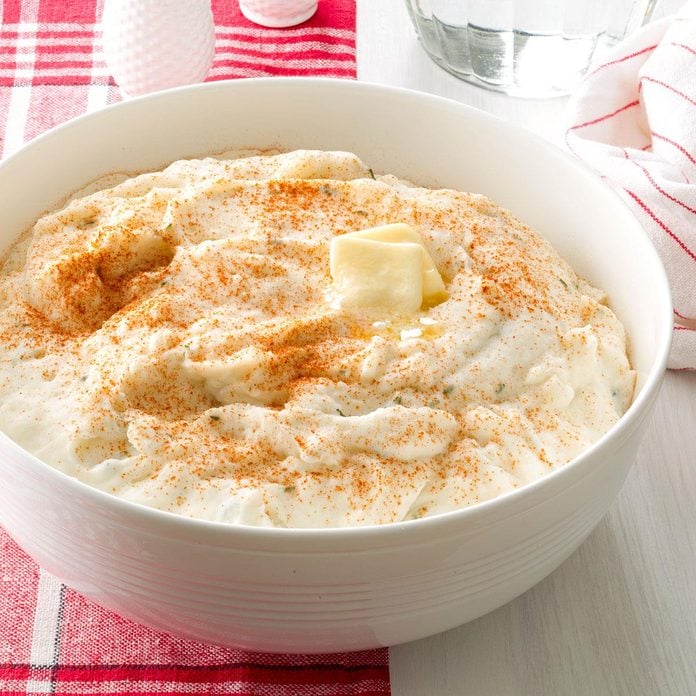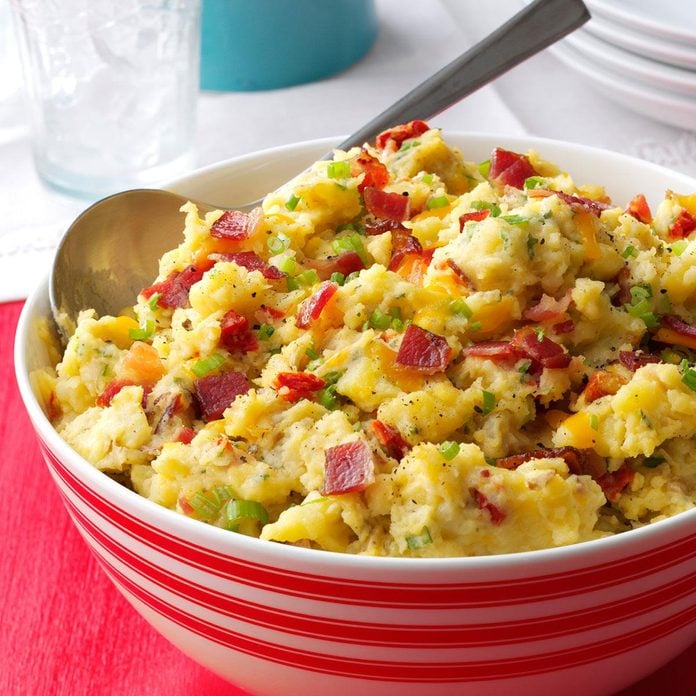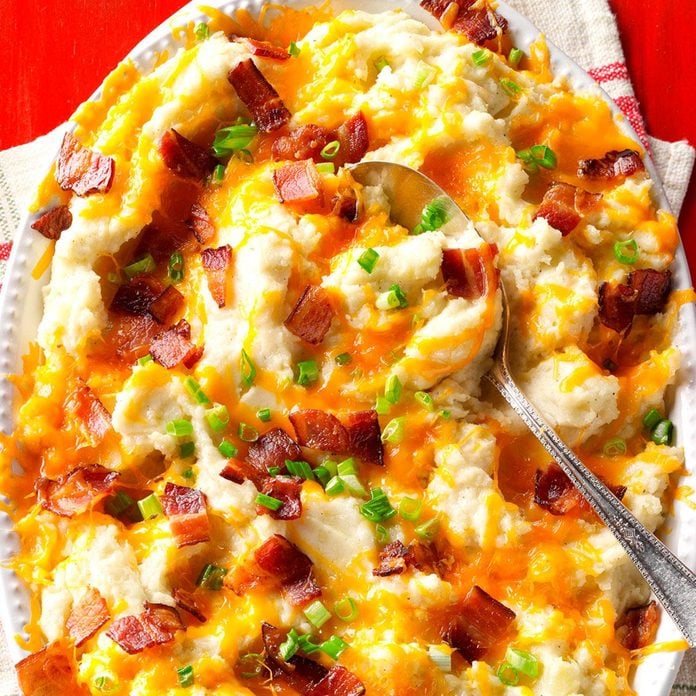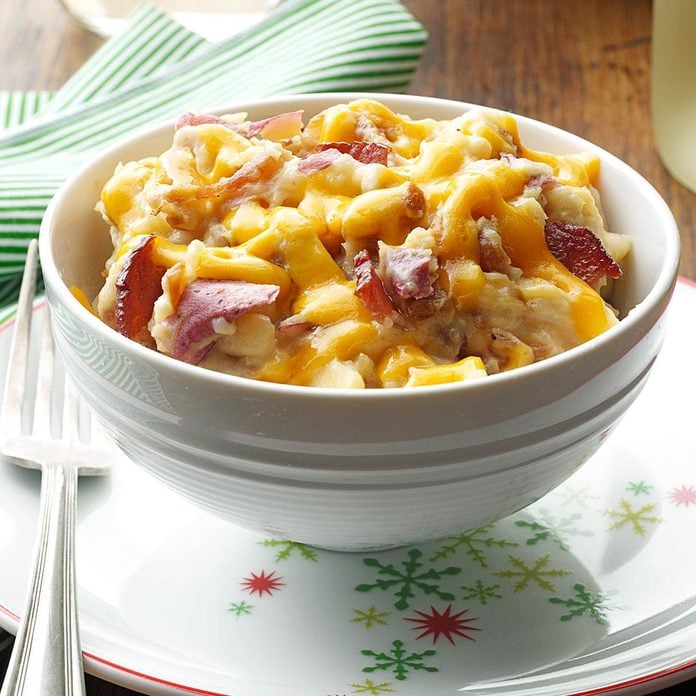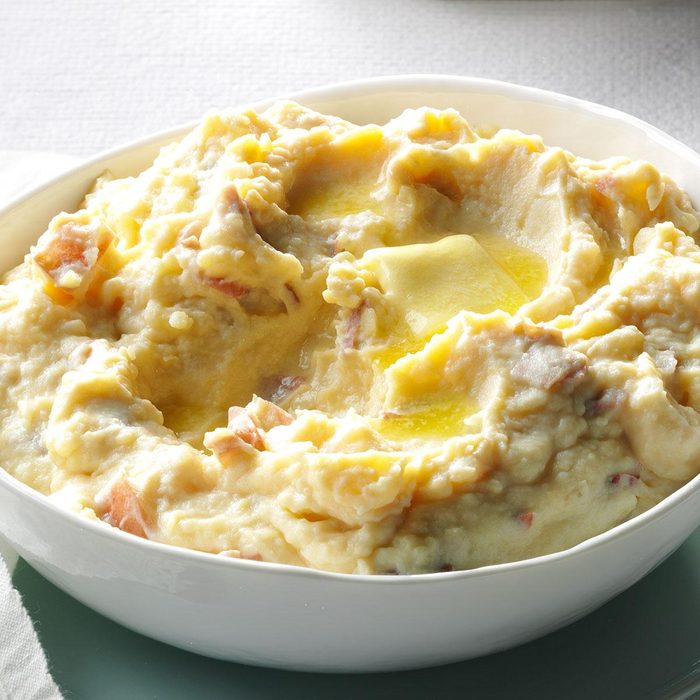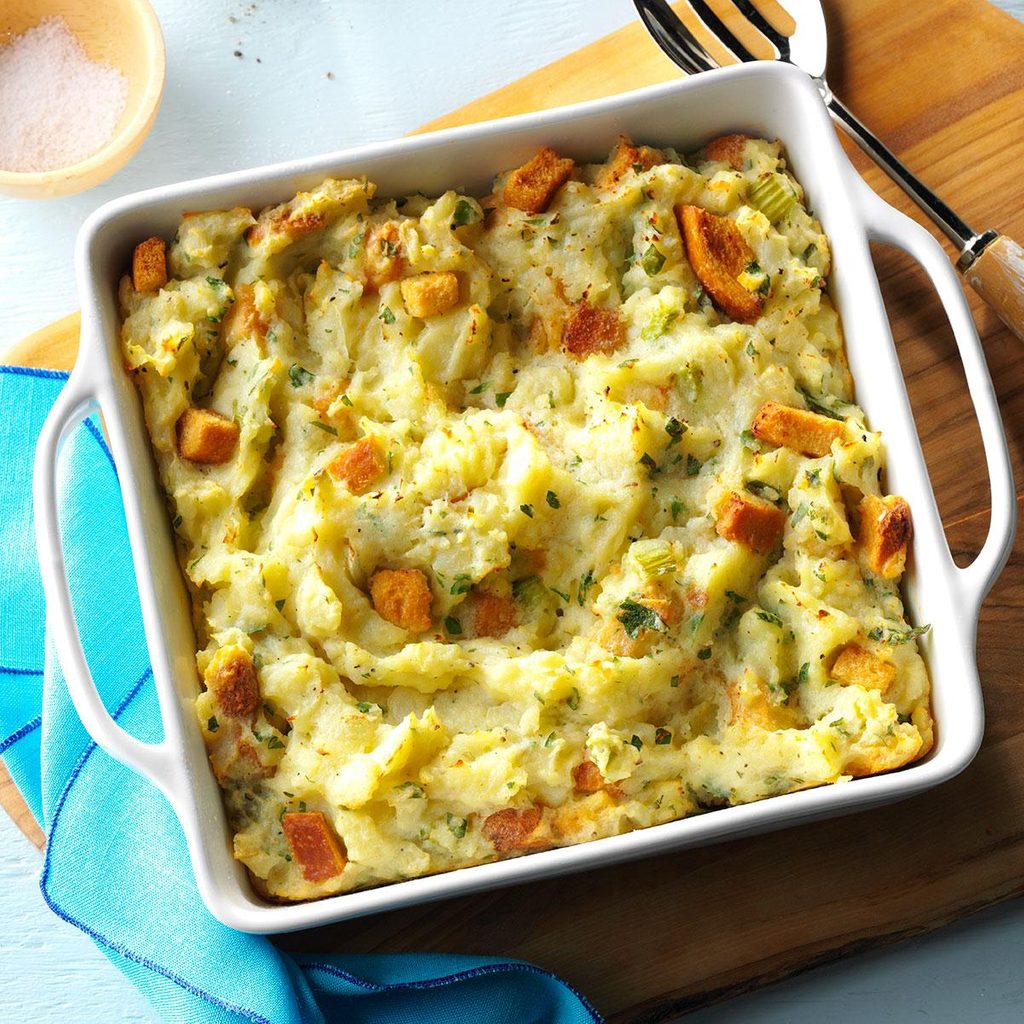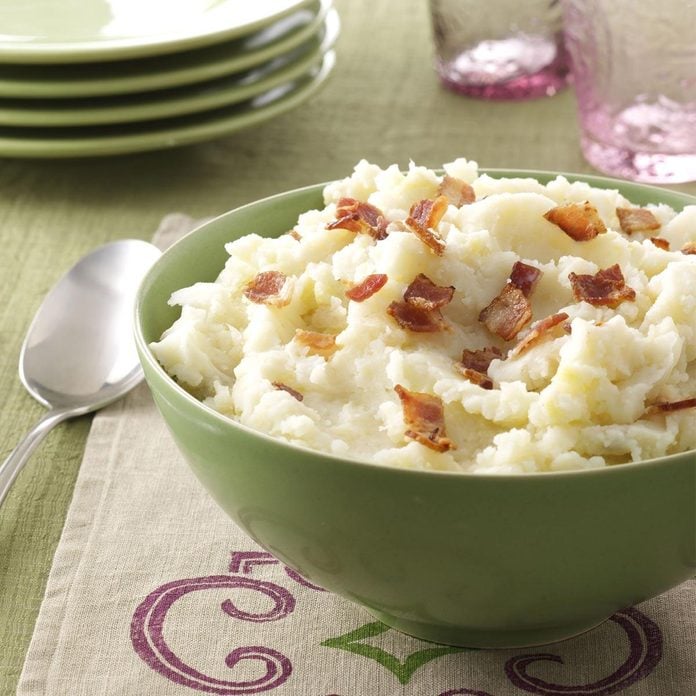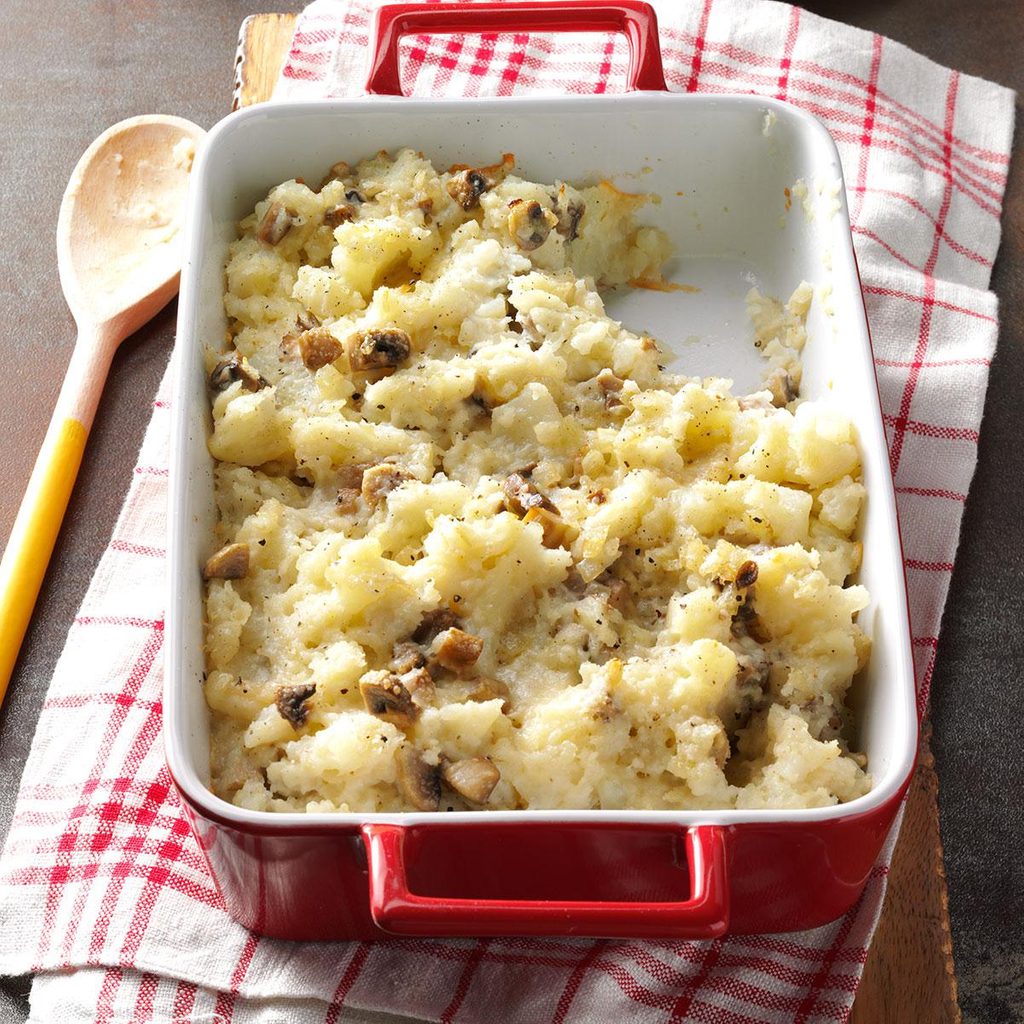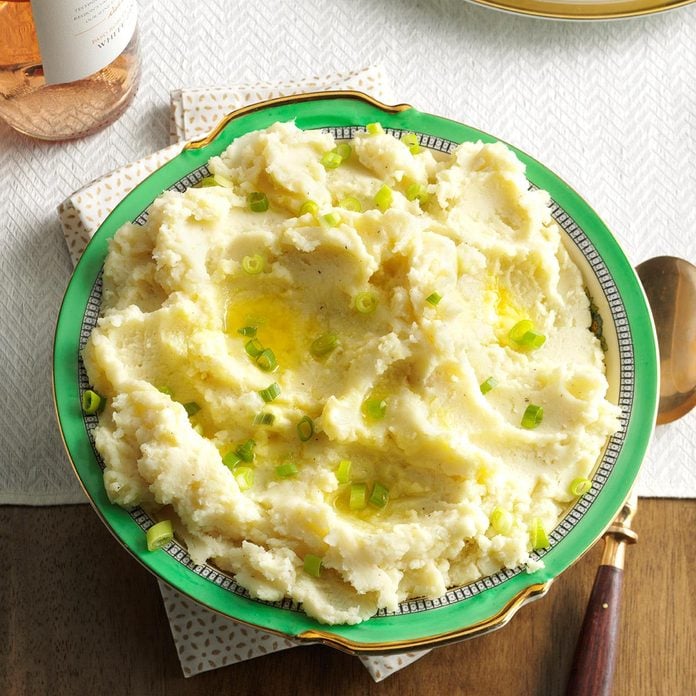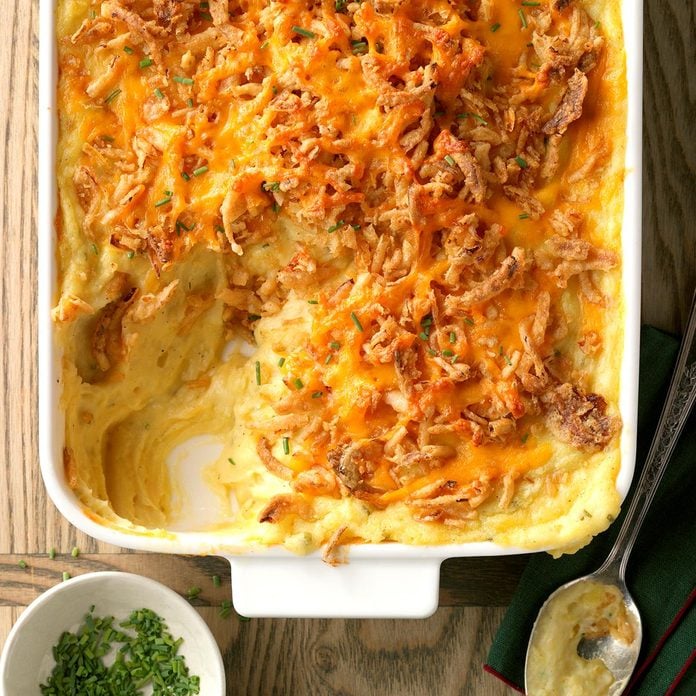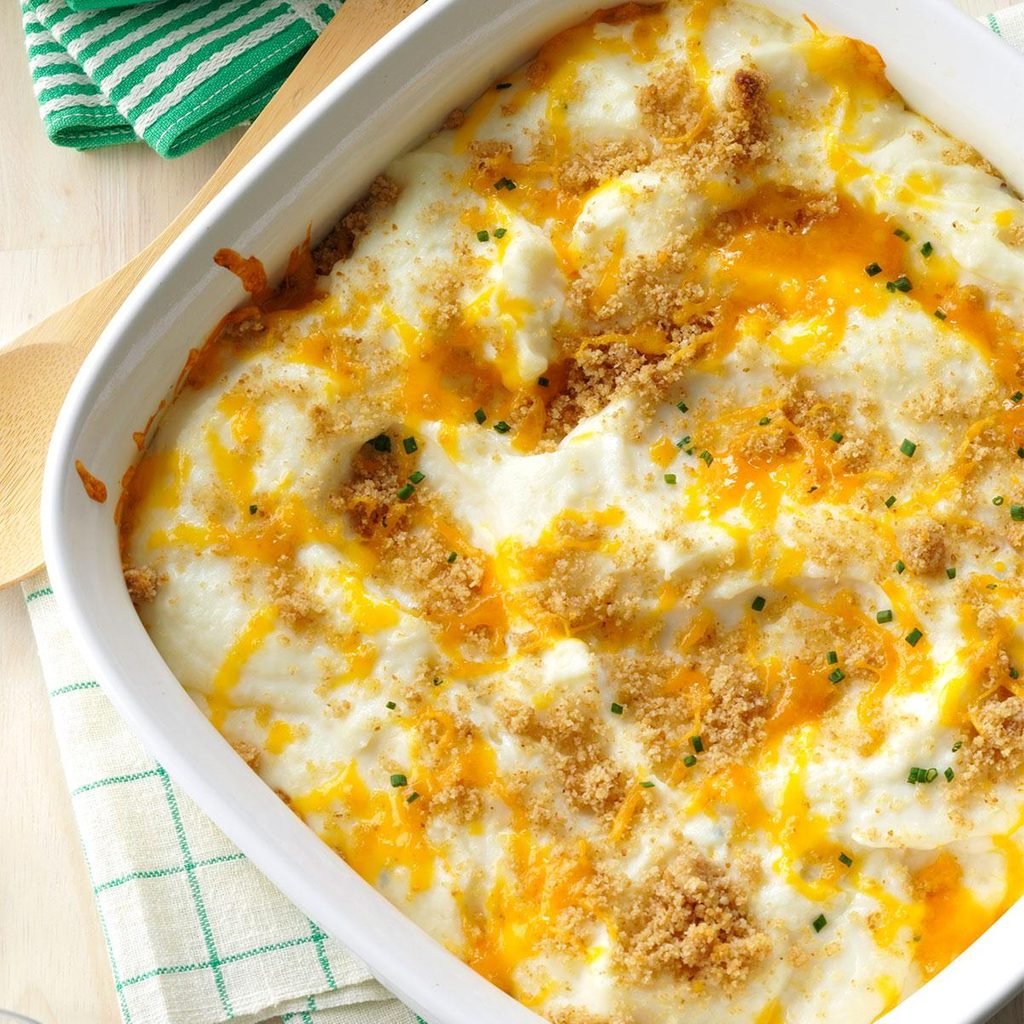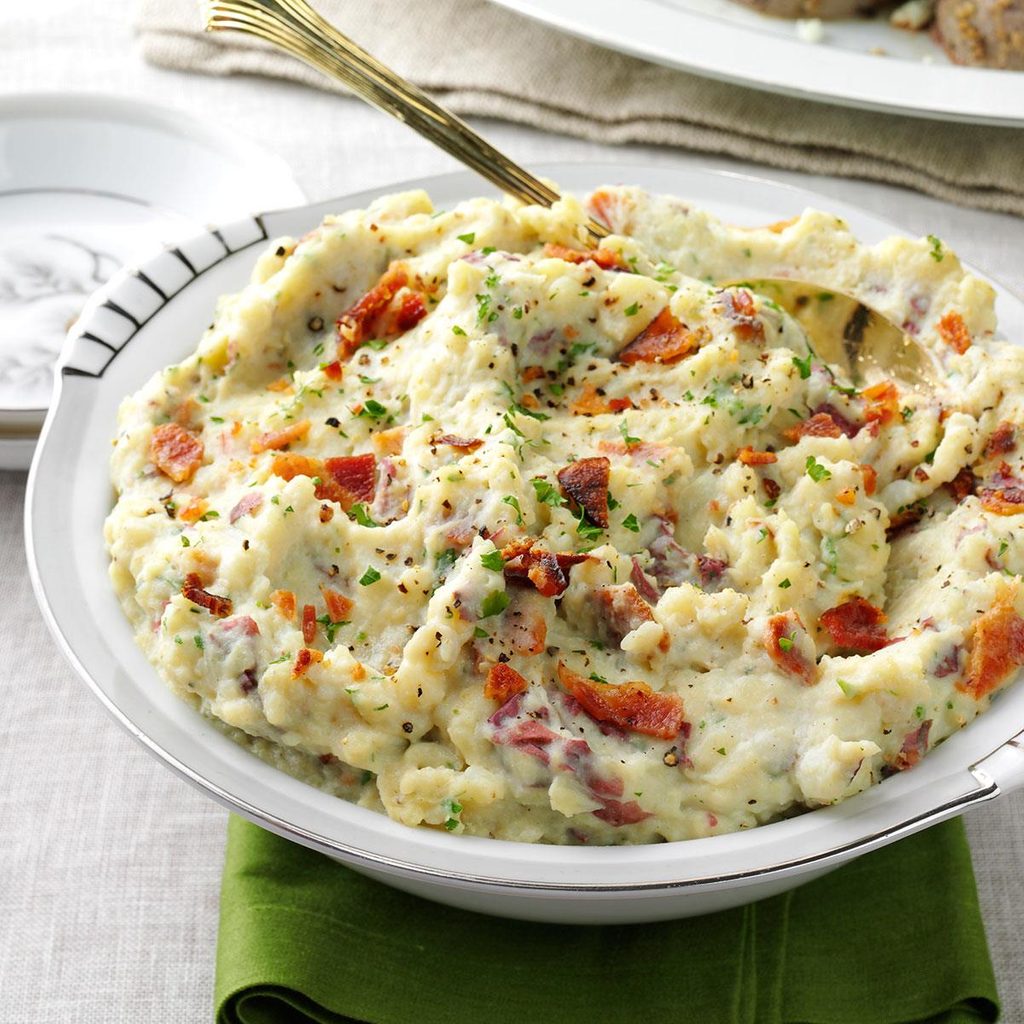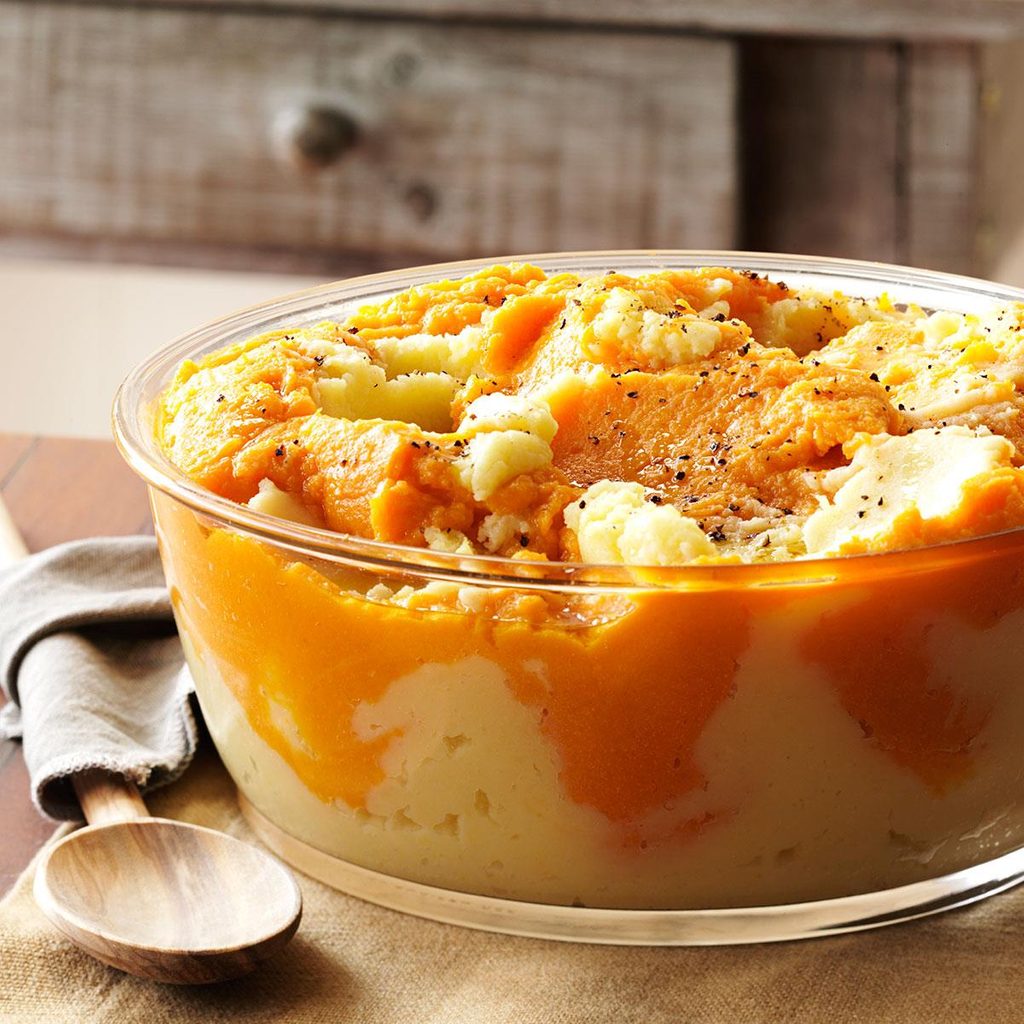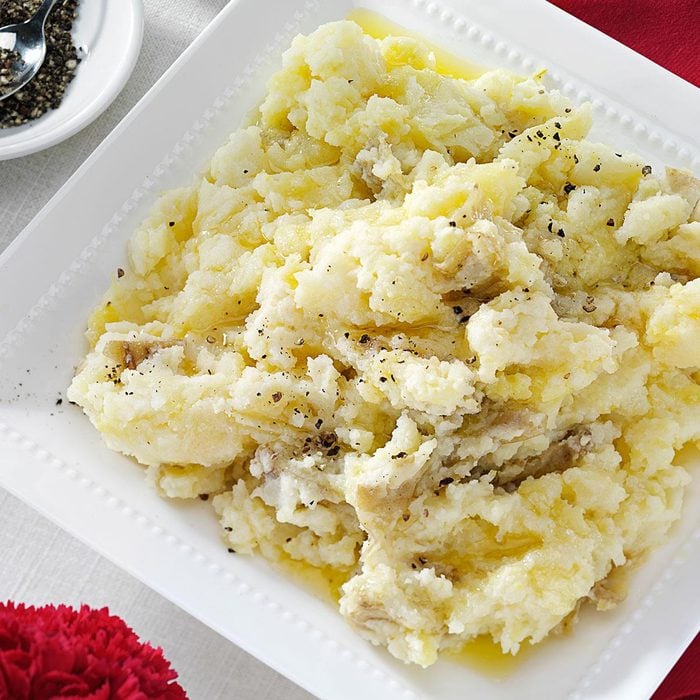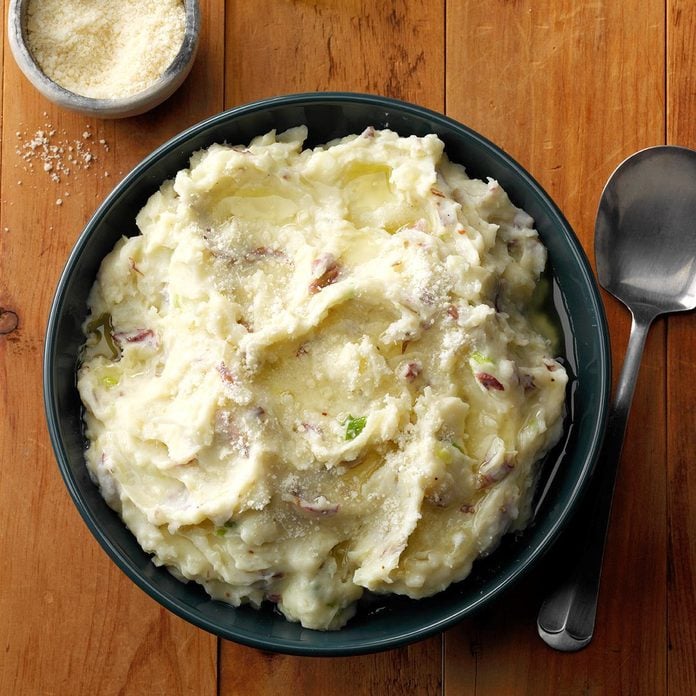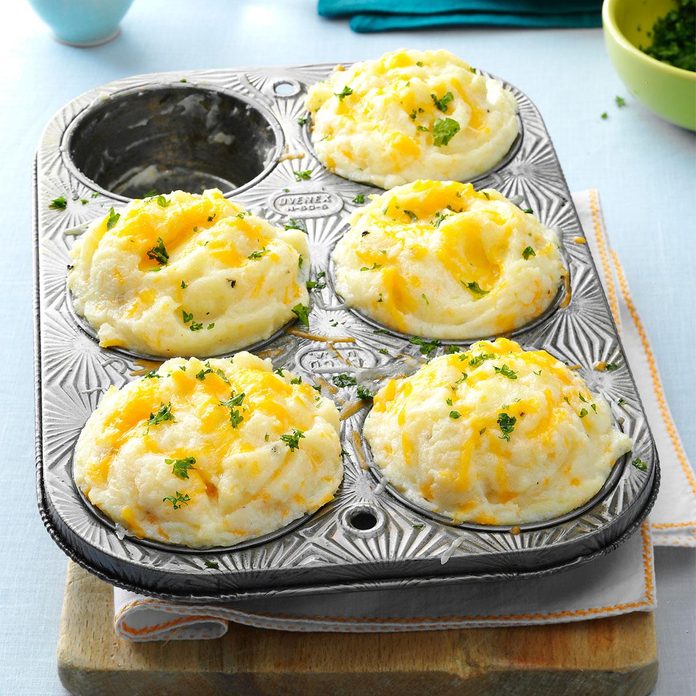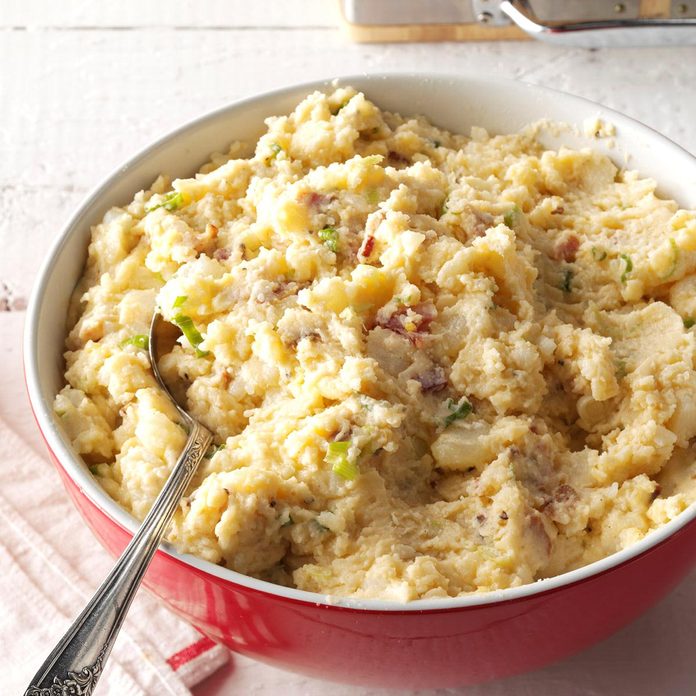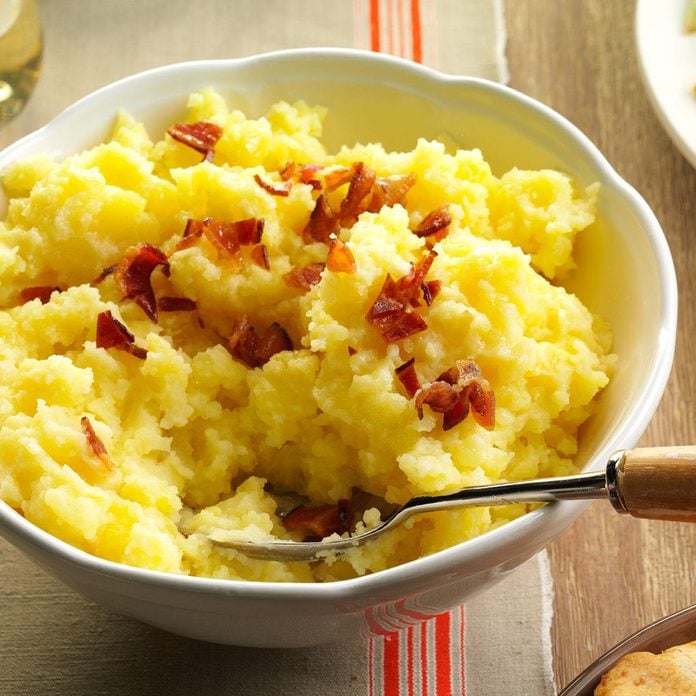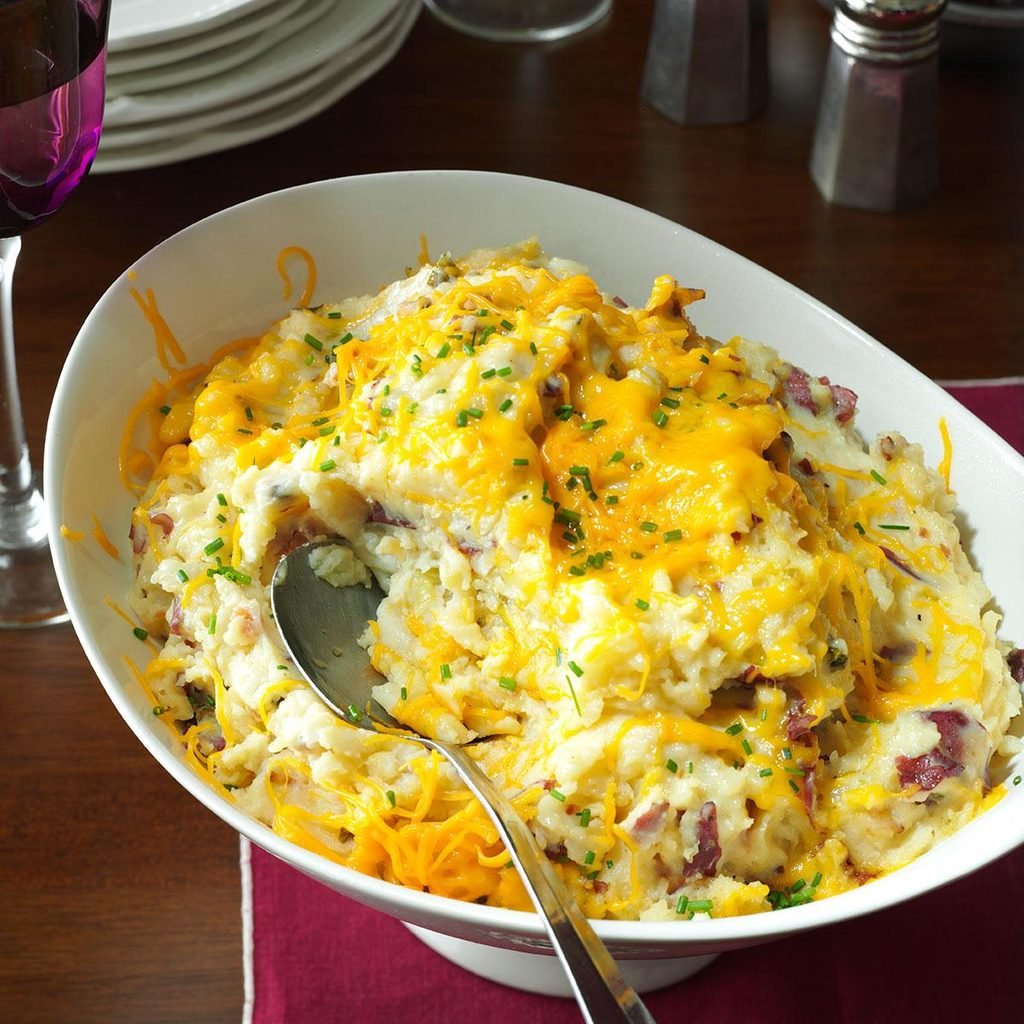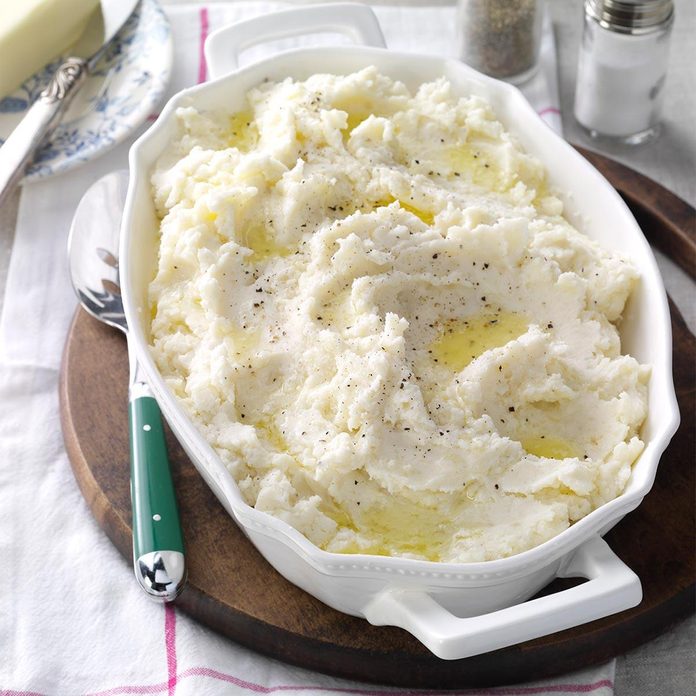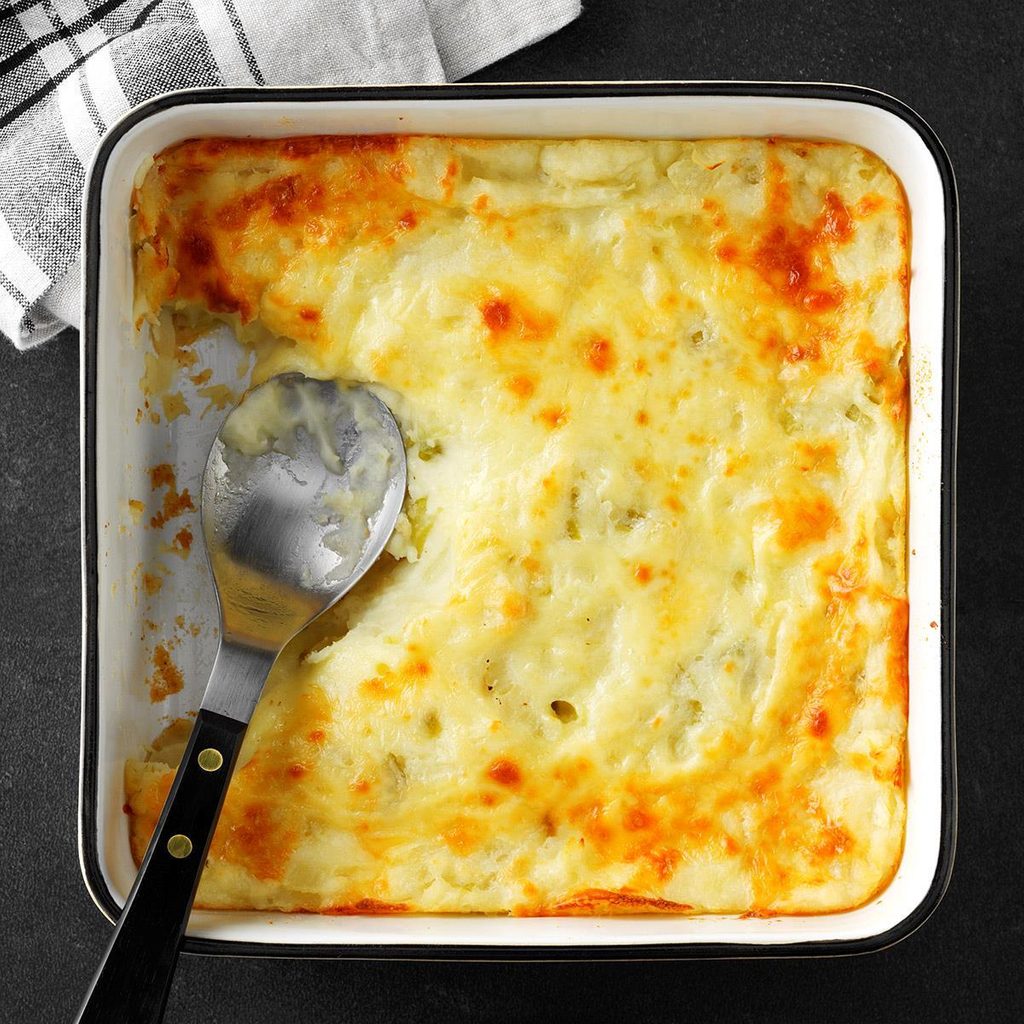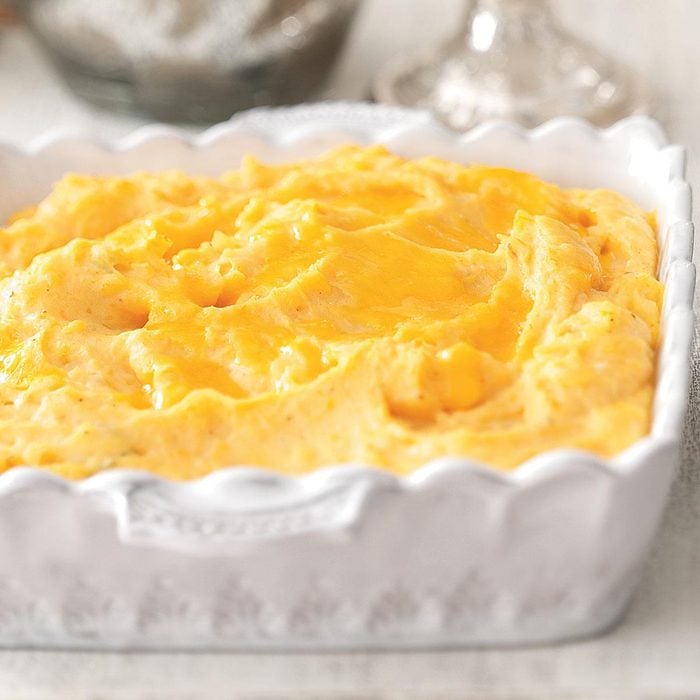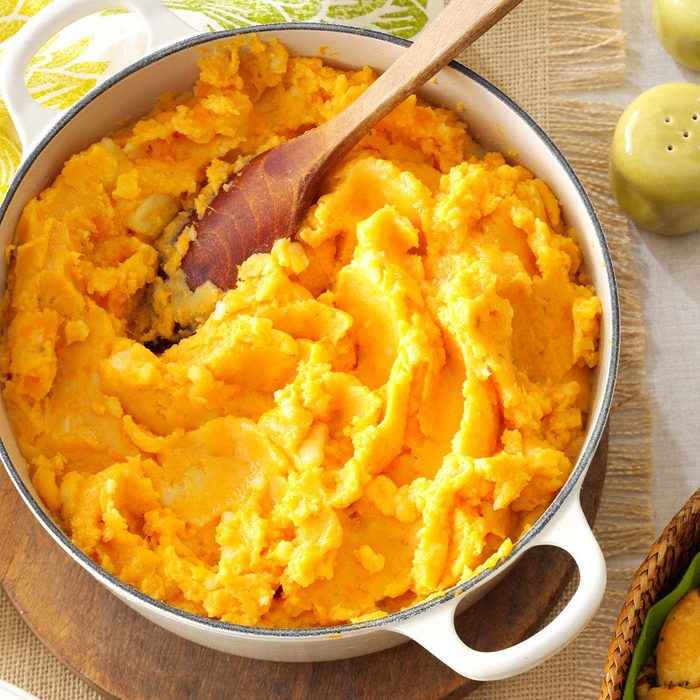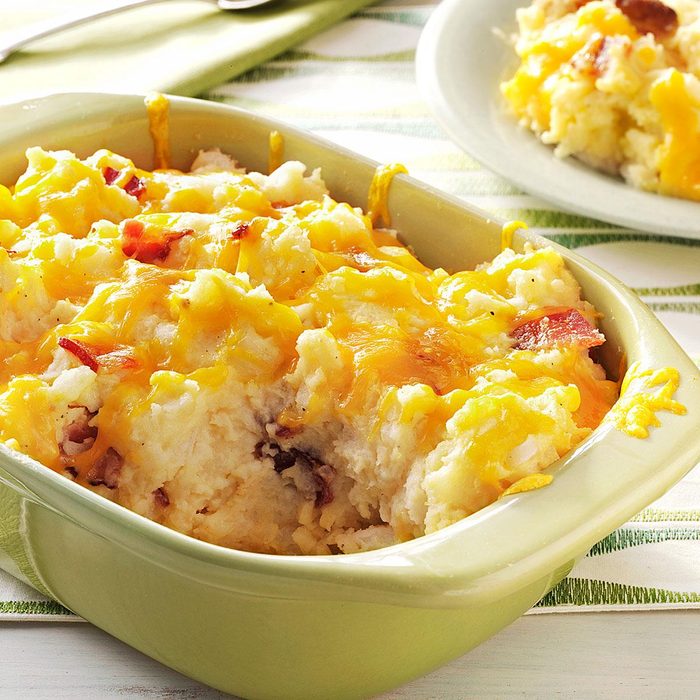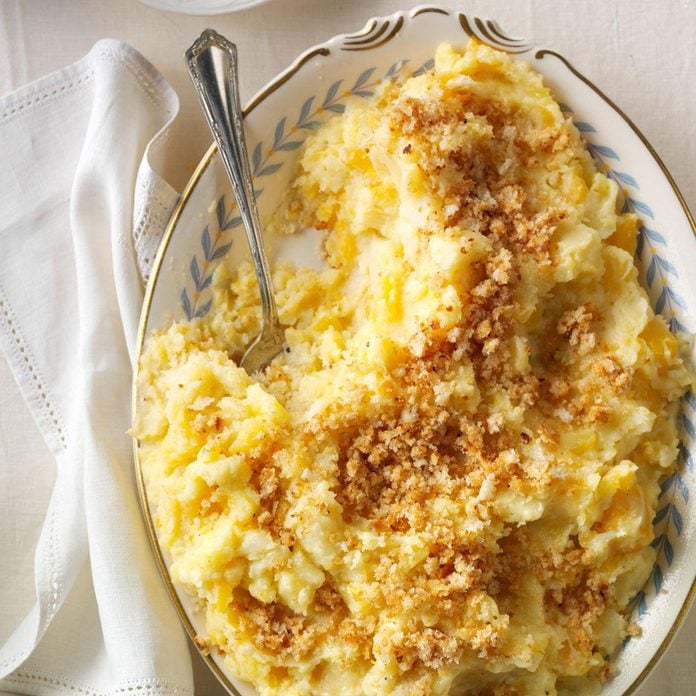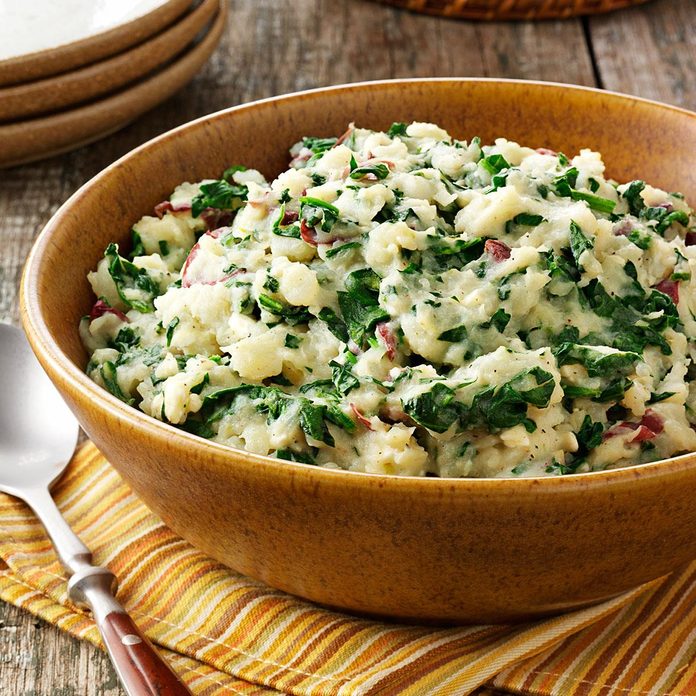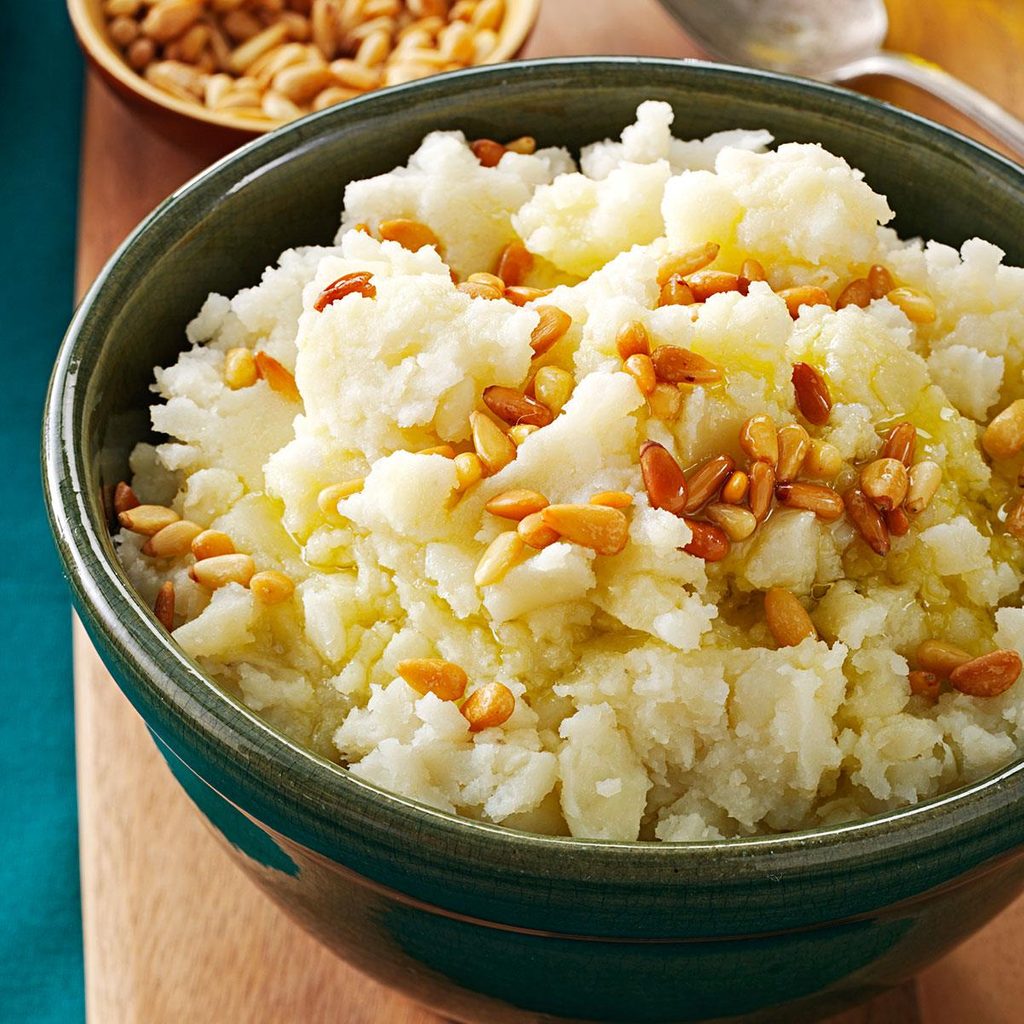ⓘ
When I was growing up, mashed potatoes were a given at dinnertime. But it wasn’t until later in life that I learned the real reason Mom liked to serve this side so much: mashed potatoes are quick and easy to whip up! You can even make them ahead of time and reheat mashed potatoes when you’re ready.
How to Make Creamy Mashed Potatoes
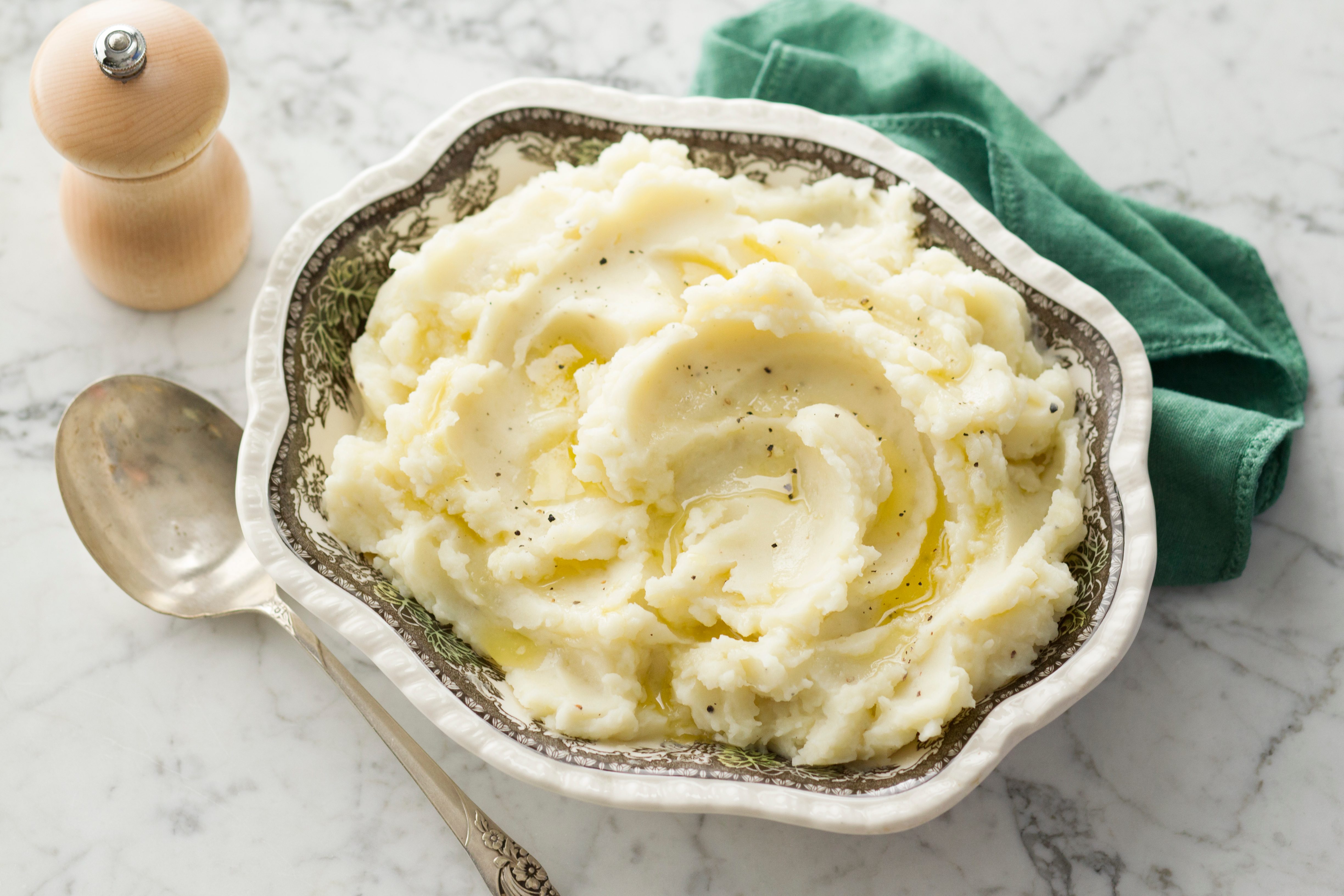
Ready to learn how to make the creamiest mashed potatoes? Follow along as we guide you through this recipe for Traditional Mashed Potatoes, just like Mom used to make. (Next: you can also take a quick look at the brilliant Pioneer Woman’s mashed potatoes recipe).
Ingredients
- 6 medium russet potatoes (about 2 pounds)
- 1/2 cup whole milk or heavy whipping cream
- 1/4 cup butter, cubed
- 3/4 teaspoon salt
- Dash pepper
Directions
Step 1: Prep the potatoes
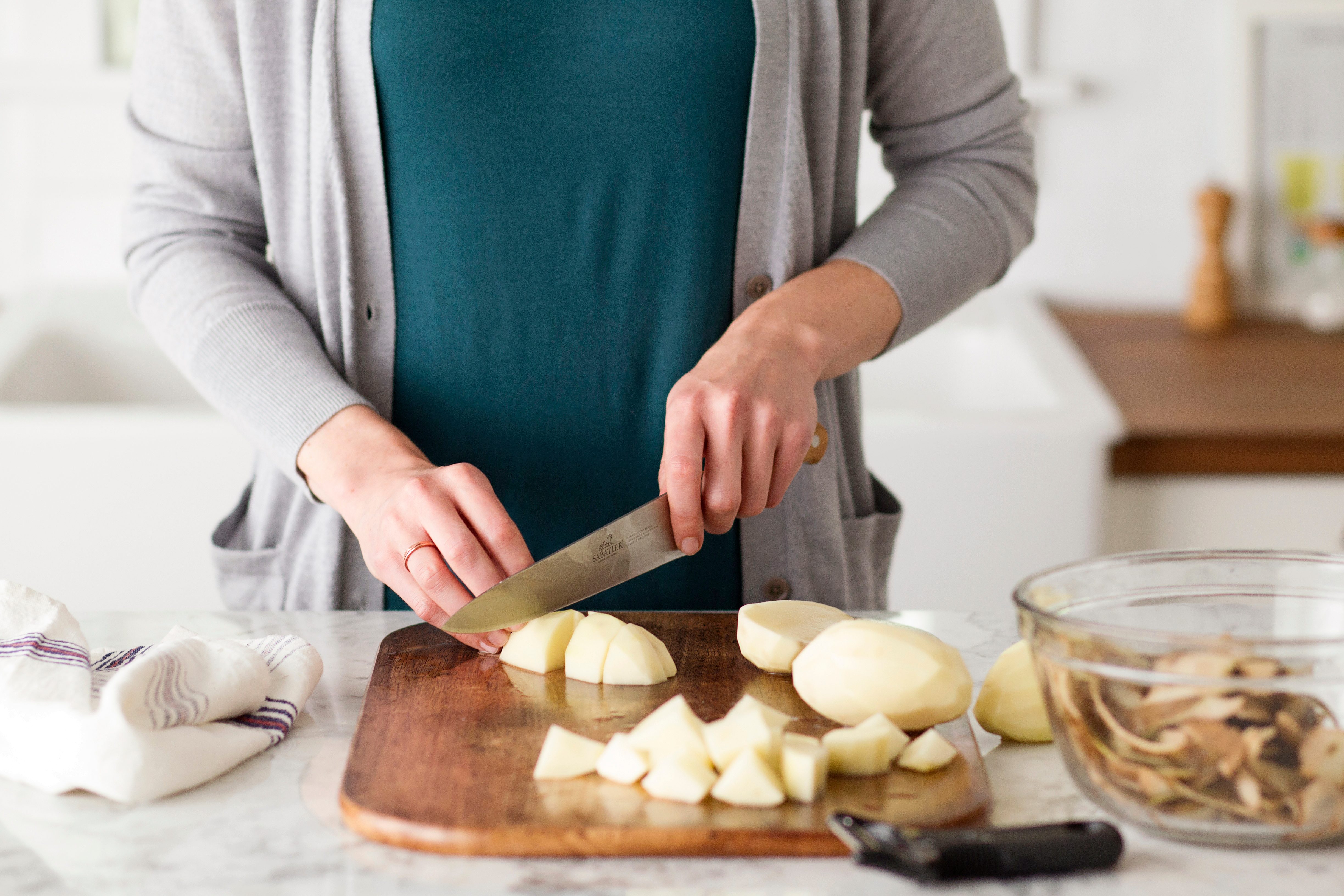 TMB Studio
TMB Studio
Before we start cooking, we need to show the potatoes some love. Grab a vegetable peeler and a chef’s knife.
Peel the potatoes one by one, sending the skins into a scrap bowl. If you find it’s taking a while to peel your taters, check out our tips on how to use a potato peeler efficiently.
Next, chop the potatoes into 2- to 3-inch pieces. While it might be tempting to cut them smaller to speed up your cook time, tiny potato pieces will absorb too much water while boiling and not absorb the butter and milk later on. You’ll also want the potato pieces to be even in size so none of them end up over- or under-cooked.
Step 2: Boil the potatoes
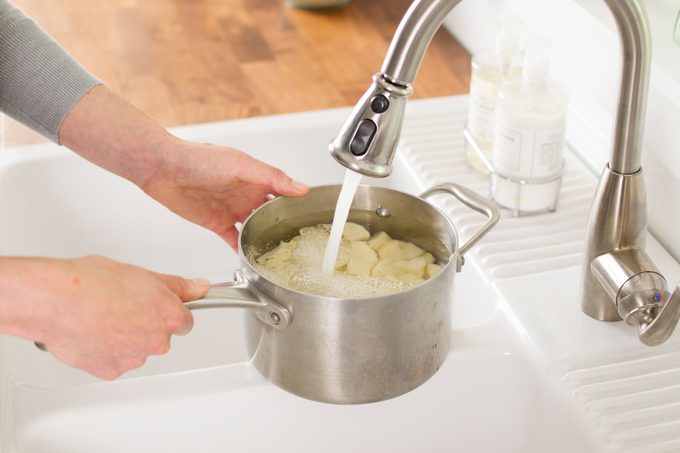 TMB Studio
TMB Studio
Place the chopped potatoes in a large saucepan and cover with water. No need to fill the pan to the brim, but make sure there’s at least an inch of water covering the potatoes.
Salt the water to season the potatoes and then bring the pot to a boil over medium to high heat. Let the potatoes cook for 20-25 minutes or until tender. You’ll know they’re ready when a fork glides through one easily.
With a slotted spoon, scoop the taters from the water. Or, using hot pads, carefully lift the pan and pour the cooked potatoes into a strainer. Whichever method you use, be sure to let the potatoes drain completely and cool until they stop steaming, so any excess moisture can evaporate.
Step 3: Prepare the cream and butter
 TMB Studio
TMB Studio
Add the cream, butter, salt and pepper to a small saucepan over low heat, stirring to combine. Heating up the dairy products first will prevent the potatoes from cooling down too much and let them absorb into the potatoes more fully for an extra-creamy and luxurious end product. For especially flavorful and rich mashed potatoes, use our Test Kitchen’s pick for the best butter.
Once the butter has melted and the cream is steaming, but not boiling, cut the heat.
Editor’s Tip: Before adding your butter to the saucepan, let it come up to room temperature. This will allow the cubes to melt quickly so the cream or milk doesn’t scorch.
Step 4: Mash the potatoes
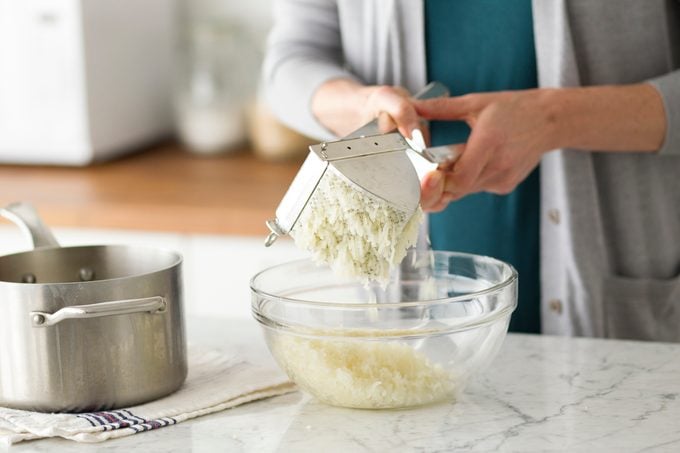 TMB Studio
TMB Studio
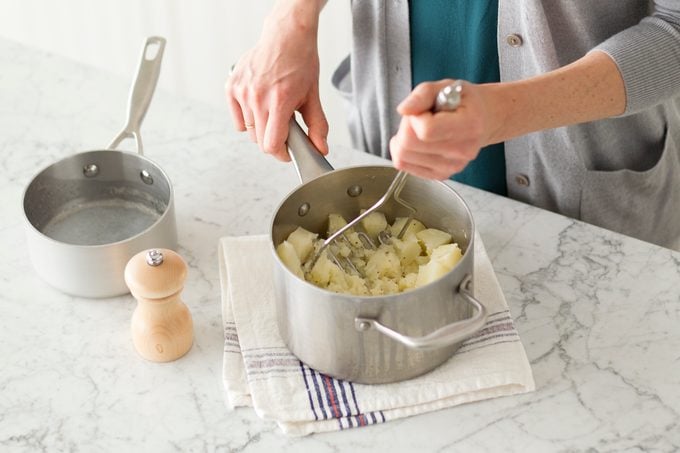 TMB Studio
TMB Studio
Now it’s time to mash! We recommend using a potato ricer for super smooth and fluffy mashed potatoes. It may be old school, but a potato ricer is one of the heirloom kitchen tools we’ll never ditch. To use one, simply place a few pieces of potato into the ricer and press down on the handle over a large bowl. Continue ricing potato piece by potato piece until you have a bowl full of potato squiggles. Then, pour the warmed cream mixture over the potatoes and stir to combine.
If you don’t have a ricer, use a potato masher. Place all of your potatoes and the cream mixture in a large bowl and mash away until they reach your desired consistency. Be sure not to over-mash or mix the potatoes. Doing so will cause them to be goopy and gluey. Here’s more on the best ways to mash potatoes.
Editor’s Tip: Resist the temptation to dump the cooked potatoes into a food processor or blender. These machines will severely overwork your potatoes and give them a gluey texture. Ick! Check out these other common mashed potato mistakes to avoid.
Step 5: Serve the mashed potatoes
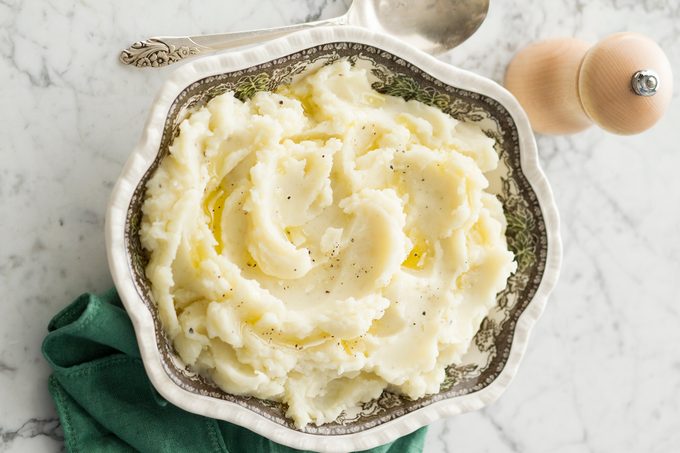 TMB Studio
TMB Studio
Time to enjoy these perfect mashed potatoes! Gobble them up by the spoonful straight from the bowl, or transfer to a serving plate and pair with a savory main course.
Mashed Potato Variations
Now that you know the basics, our Test Kitchen offers some insanely tasty upgrades to the basic mash:
- Herbed mashed potatoes: Add 2-3 tablespoons of thinly sliced green onions, snipped chives or chopped parsley.
- Garlic mashed potatoes: Add 10-12 cloves of oven-roasted garlic, chopped or minced.
- Baked mashed potatoes: Put the potatoes in an oven-safe dish, top with 2 tablespoons of bread crumbs and 1 tablespoon of grated Parmesan, and then broil until golden brown (1-2 minutes).
- Rich and creamy mashed potatoes: Take a tip from the Pioneer Woman’s mashed potatoes and add softened cream cheese and seasoned salt to your mashed taters.
- Vegan mashed potatoes: Replace the milk and butter with vegetable broth, unsweetened almond milk and a bit of vegan butter.
Tips for the Creamiest Mashed Potatoes
What kind of potatoes are best for mashed potatoes?
Though russet potatoes are the traditional choice, feel free to use any potato you’d like. Our tasting panel also gave high marks to recipes featuring Yukon Golds and red potatoes. Here’s more on what to make with every type of potato.
Do you need to peel the potatoes?
If you’re pressed for time, feel free to leave the skin on the potatoes—just be sure to scrub them well. The end result won’t be as smooth or picture-perfect, but some of us prefer things that way.
How do you reheat mashed potatoes?
If you plan on saving the mashed potatoes for later, let them cool and then store in an airtight container in the fridge for up to four days. When you’re ready to eat the leftovers, microwave them on high, stirring every 30 seconds until heated through.
More Mashed Potato Recipes You'll Love
Buttermilk Mashed PotatoesMy sister-in-law, who is a dietitian, shared these buttermilk
mashed potatoes with me. The garlic and buttermilk in these smooth mashed potatoes that are better for you than typical versions that include lots of butter. —Stephanie Bremson of Kansas City, Missouri
Editor's Tip: You get ready to chop potatoes for dinner and notice some unwelcome "eyes." Immediately, you wonder,
Are sprouted potatoes safe to eat? Check if
can you eat a potato that is sprouting.
Colcannon PotatoesEvery Irish family has its own colcannon recipe, since it's a classic potato and cabbage dish. My recipe comes from my father's family in Ireland. It's part of my St. Patrick's Day menu, along with lamb chops, carrots and soda bread. —Marilou Robinson, Portland, Oregon
Cheese Smashed PotatoesWho doesn't like mashed potatoes? Try this slimmed-down dish with any entree. —Janet Homes, Surprise, Arizona
Twice-Baked Cheddar Potato CasseroleBacon, cheddar and sour cream turn ordinary potatoes into an extraordinary twice baked potato casserole. It's one of our family's beloved standards for the holidays. —Kyle Cox, Scottsdale, Arizona
Sour Cream PotatoesOne of the great things about these creamy potatoes is they turn out even better if you make them a couple days ahead and bake them on the day you serve them till they're golden brown on top.—Krista Smith Kliebensteain, Broomfield, Colorado
Loaded Smashed TatersYou can make an entire pot of smashed taters in the time it takes to bake a single potato! I like to use baby Yukon Golds because the skins are very thin and easy to mash. Make this to your taste—sometimes I add in garlic and chives or sub shallots for the green onions. My husband loves these potatoes with steak, and even my 20-month-old daughter enjoys them! —Andrea Quiroz, Chicago, Illinois
Creamy Make-Ahead Mashed PotatoesWith five different dairy products, you know this make-ahead mashed potato casserole is going to be super rich and, of course, delicious. It gets even better topped with onions and bacon! —JoAnn Koerkenmeier, Damiansville, Illinois
Caramelized Onion Mashed PotatoesCaramelized onions give a sweet and savory taste to this side dish from our Test Kitchen. Prepared with red potatoes, reduced-fat cheese and bacon, it makes a heartwarming accompaniment to any main course.—Taste of Home Test Kitchen
Rich & Creamy Parmesan Mashed PotatoesFor special occasions (like my husband’s birthday dinners), I mash potatoes with cream cheese, sour cream and Parmesan. It's divine comfort food. —Jo Ann Burrington, Osceola, Indiana
Potato Stuffing CasseroleI adapted this recipe from a Pennsylvania Dutch cookbook, and it's indicative of the fine German cooking found in this area. If you're looking for an alternative to mashed potatoes, try this dish. —Elsa Kerschner, Kunkletown, Pennsylvania
Apple Mashed PotatoesI love potatoes…especially mashed. When I came up with this combination, it was declared a winner. I serve this as a side dish when I have pork as an entree, but it's great with any meat. —Rebecca Page, Pensacola, Florida
Creamy Mushroom-Potato BakeThe day I first made this, we'd invited a neighbor—a bachelor farmer—over, and I wanted to fix something hearty. It was a hit instantly. These days, our three sons enjoy it as a change from regular mashed potatoes. We've found that it's best served with beef...either with or without gravy. —Kathy Smith, Granger, Indiana
Cream Cheese Mashed PotatoesWhenever I serve this easy mash, the bowl is always scraped clean. Before holiday feasts, I make it early and keep it warm in a slow cooker so I can focus on last-minute details. —Jill Thomas, Washington, Indiana
Cheddar and Chive Mashed PotatoesMy husband swears my cheddar mashed potatoes are the world's best. We always have some in the freezer. Sometimes I dollop individual servings in muffin cups and reheat them that way instead. —Cynthia Gerken, Naples, Florida
Party PotatoesThese creamy, tasty potatoes can be made the day before and stored in the refrigerator until you're ready to pop them in the oven (I often do that). The garlic powder and chives add zip, and the shredded cheese adds color. —Sharon Mensing, Greenfield, Iowa
Stilton, Bacon & Garlic Smashed PotatoesBold, savory flavor from bacon, Stilton cheese and fresh garlic take mashed potatoes to a whole new level. This side dish is so rich and satisfying, it could be eaten as an entree! —Jamie Brown-Miller, Napa, California
Potato Pumpkin MashNo more plain white mashed potatoes for us! I swirl fresh pumpkin into potatoes for a little extra holiday color. — Michelle Medley, Dallas, Texas
Chunky Garlic Mashed PotatoesI like to dress up these mashed spuds with a whole bulb of roasted garlic. It may seem like overkill, but once cooked, any harshness mellows out and you're left with sweet and delicate garlic flavor. —Mrs. Jackie Gregston, Hallsville, Texas
Mashed Potatoes with Garlic-Olive OilGarlic mashed potatoes are high on our love list. To intensify the flavor, I combine garlic and olive oil in the food processor and drizzle it on top of the potatoes. — Emory Doty, Jasper, Georgia
Confetti Mashed PotatoesThese mashed potatoes make a beautiful side dish for any meal. Onion, peppers and cheese add color and flavor to the potatoes. —LaDonna Reed, Ponca City, Oklahoma
Mashed Potato CupsI came up with this recipe as a way to use up leftover mashed potatoes. It's a nice alternative to the standard potatoes or rice. —Jill Hancock, Nashua, New Hampshire
Slow-Cooker Loaded Mashed PotatoesEvery year my Mom made cream cheese mashed potatoes for Thanksgiving. I tailored the recipe to my family's taste and carried on the tradition. I make them a day ahead and use my slow cooker to free up oven space for other dishes. —Ann Nolte, Tampa, Florida
Buttermilk Smashed PotatoesMy family loves this decadent homestyle recipe of buttermilk, potatoes and butter. Serve with your favorite toppings and enjoy! —Marla Clark, Albuquerque, New Mexico
Loaded Smashed PotatoesIf mashed potatoes are a must at your family Thanksgiving, then why not go all out with the works? I love garlic, onions and bacon, and this dish has all three! —Kathy Harding, Richmond, Missouri
Classic Make-Ahead Mashed PotatoesThese make-ahead mashed potatoes save me a ton of time on Christmas Day. No more frantically whipping the potatoes while hungry family and guests hang around the kitchen! —Marty Rummel, Trout Lake, Washington
Mozzarella Mashed Potato RemixHere's a yummy way to finish off extra mashed potatoes. The gooey cheese, creamy potatoes and golden crust blend perfectly to create spud heaven. Your family will love this mashed potato casserole!—Rosemarie Weleski, Natrona Heights, Pennsylvania
Cheddar Cheese Mashed PotatoesA sweet potato added to the usual Yukon golds gives these cheesy potatoes a slightly sweet flavor and nice rich color. No one will believe they’re lighter. —Connie Boll, Chilton, Wisconsin
Gouda Mixed Potato MashEverything's better with cheese, right? This cheesy two-potato mash is no exception. If you cube the cheese, you’ll discover delicious pockets of melted cheese throughout the dish. —Shelby Goddard, Baton Rouge, Louisiana
Double-Baked Mashed PotatoesDress up an all-time favorite comfort food with savory fixings. This is an easy twice baked mashed potatoes recipe that delivers big flavor. Better still, you can effortlessly double or triple it for a crowd. —Anna Mayer, Fort Branch, Indiana
Triple Mash with Horseradish Bread CrumbsWhy settle for traditional mashed potatoes when you can enjoy three times the flavor? Combine spuds with rutabaga and parsnips, along with the zip of horseradish, for a taste treat. —Lily Julow, Lawrenceville, Georgia
Spanakopita Mashed PotatoesI learned to cook by watching my mom in the kitchen. Most of the recipes I make use only five or six ingredients and have a healthier bent. I created this recipe after I tried a spinach-topped baked potato. Flecks of red and green from the potato skin and spinach make these potatoes look festive and special. By not peeling the potatoes, you not only keep some nutrients, but you also save on prep time. —Ashley Levy, Columbia, Maryland
Mediterranean Mashed PotatoesIt's hard for our family to imagine eating mashed potatoes any other way but this. It tastes great on its own or drizzled with tahini sauce. —Nikki Haddad, Germantown, Maryland
Next: Check out
Pioneer Woman’s mashed potatoes recipe (the creamiest ever).








